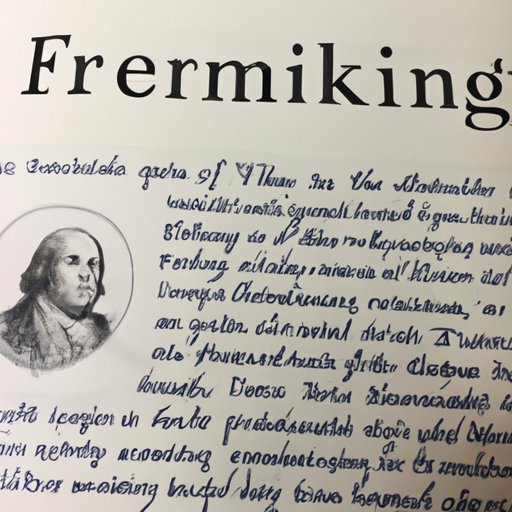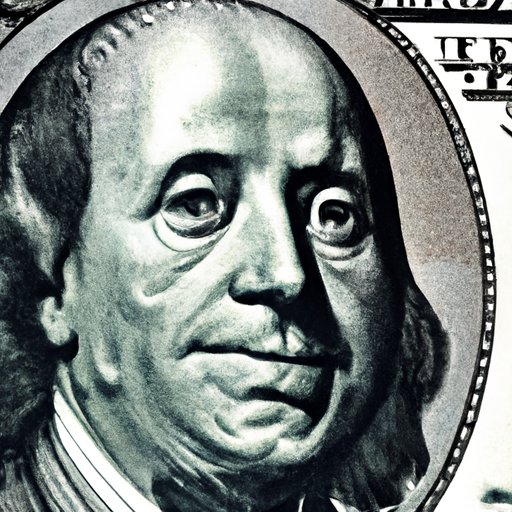Introduction
Have you ever wondered why Benjamin Franklin is featured on the $100 bill? This article aims to unravel the mystery and provide a comprehensive look into the symbolism that dictates US currency design. Throughout history, the faces of political figures, founding fathers, and prominent American figures have been emblazoned on various US bills. Benjamin Franklin is one of the most notable figures in American history and played an integral role in shaping the country into what it is today. Let’s explore why the $100 bill features one of America’s most renowned scholars, experimenters, and founding fathers.

Exploring the Life and Achievements of Benjamin Franklin
Born in 1706 in Boston, Massachusetts, Benjamin Franklin was an American Renaissance man who profoundly impacted science, politics, and diplomacy. He was a printer, journalist, politician, inventor, and philosopher. His contributions to American society were significant and earned him respect throughout the world.
Franklin was considered one of the country’s founding fathers, and his political legacy is evident in his role in drafting the Declaration of Independence. He was also instrumental in negotiating the Treaty of Paris, which ended the Revolutionary War. As one of the most astute diplomats of the time, Franklin served a critical role in negotiating peace with England on America’s behalf.
Franklin was also a skilled scientist and inventor whose discoveries were groundbreaking. One of his most notable inventions is the lightning rod, which protects buildings from lightning strikes. His passion for science led him to make numerous contributions to society, including developing bifocal glasses and discovering that lightning was actually electricity.
Tracing the History of US Currency and the Selection Process for the $100 Bill
The history of US currency dates back to the country’s early days, where printed paper currency was used as a substitute for gold or silver. The modern US currency we know today originated in 1914 with the creation of the Federal Reserve.
The process of selecting designs for US currency has changed over the years. Today, the selection process is overseen by the Secretary of the Treasury, who is responsible for choosing the images on US bills. Historically, presidents and other political figures were the standard faces of US currency. However, in the 20th century, the Treasury began featuring prominent Americans who have made significant contributions to American society and culture.
Benjamin Franklin’s selection as the face of the $100 bill dates back to 1914, with the introduction of the Federal Reserve Act. The act sought to create a more stable banking system by introducing a central bank. At this time, the Federal Reserve issued notes with portraitures of famous Americans. The $100 note featured Benjamin Franklin, who had been previously featured on silver certificates.
Analyzing the Symbolism of Benjamin Franklin on the $100 Bill
The image of Benjamin Franklin on the $100 bill represents an important symbol in American culture. As a founding father who embodied the spirit of the American Revolution, Franklin’s image represents the values that America was founded on. The $100 bill’s iconic nature intrinsically links the image of an American hero to the concepts of wealth and power.
Benjamin Franklin’s image on the $100 bill also represents his influence on American politics, economy, and society. Franklin played a pivotal role in American politics, including serving as a delegate to the Continental Congress and helping draft the US Constitution. Franklin’s image on the $100 bill serves as a reminder of the impact he had on the country’s political foundations.
Furthermore, Franklin was a successful businessman and played a critical economic role in American society. He established the first newspaper chain in America in addition to founding the first public library and fire department. Franklin’s support of education and literacy is also represented by his image on the $100 bill.
Examining the Evolution of the $100 Bill Design
Over the years, the design of the $100 bill has undergone various changes. The most recent design overhaul occurred in 2013, which introduced new security features such as a 3D security ribbon and a color-changing inkwell. One interesting feature of the current design is that it incorporates Benjamin Franklin’s portrait in both the watermark and the security thread.
The current design of the $100 bill is the culmination of years of evolution and innovation. Benjamin Franklin’s image has remained a constant focus of the bill, and its incorporation into the design has been done in creative and inventive ways.
Comparing and Contrasting Benjamin Franklin to Other Figures on US Currency
Benjamin Franklin is not the only notable figure to appear on US currency. Arguably, one of the most significant figures is George Washington, who appears on the one-dollar bill. Other notable figures include Abraham Lincoln on the five-dollar bill and Thomas Jefferson on the twenty-dollar bill.
However, Benjamin Franklin’s role on the $100 bill offers some unique features. Unlike the other faces of US currency, Franklin was never a president. Instead, he was one of the country’s most respected and influential founding fathers, whose contributions to the country went far beyond politics.
Critically Analyzing Controversies and Criticisms Surrounding US Currency
There have been numerous controversies surrounding US currency design and the figures that appear on them. One of the most significant criticisms is the lack of diversity among those featured on US bills. While Benjamin Franklin was not a president, he was a white male, which led to criticism that the Treasury chose only prominent white men.
However, efforts have been made in recent years to address this issue. For example, in 2020, the Treasury announced that Harriet Tubman, a former African American slave and abolitionist, would be featured on the $20 bill.
Exploring the Cultural and Educational Impact of Benjamin Franklin on the $100 Bill
Benjamin Franklin’s image on the $100 bill has contributed to its cultural and educational impact. As one of the most recognized and valuable bills in circulation, the $100 bill has become an iconic symbol of American wealth and success. Additionally, the bill’s high value reflects the importance that society places on financial wealth, and its inclusion of Benjamin Franklin’s image only serves to enhance this symbolism.
The inclusion of Benjamin Franklin’s image on the $100 bill has also had an educational impact. The importance of Benjamin Franklin’s role in American politics, economy, and society is not lost on the youth. The presence of his image on the bill has sparked interest in American history and has led to an increased understanding of the founding fathers and their contributions to America.
Conclusion
In conclusion, Benjamin Franklin’s image on the $100 bill represents the values and foundations upon which America was built. Franklin’s contributions to science, politics, and society were significant, and his image on the $100 bill serves as a constant reminder of his influence on American history. As the currency design continues to evolve, it is important to reflect on the significance of figures such as Benjamin Franklin and the impact they have had on American culture and identity.
If you enjoyed this article and the insights it provided, we encourage you to learn more about American history and the contributions of our founding fathers.
